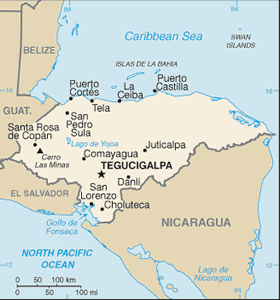The Geography of Honduras
The Geography of Honduras
Honduran Geography
Location: Central America, bordering the Caribbean Sea, between Guatemala and Nicaragua and bordering the Gulf of Fonseca (North Pacific Ocean), between El Salvador and Nicaragua
Geographic coordinates: 15 00 N, 86 30 W
Map references: Central America and the Caribbean
Area: total: 112,090 sq km land: 111,890 sq km water: 200 sq km
Area - comparative: slightly larger than Tennessee
Land boundaries: total: 1,520 km border countries: Guatemala 256 km, El Salvador 342 km, Nicaragua 922 km
Coastline: 820 km
Maritime claims: territorial sea: 12 nm contiguous zone: 24 nm exclusive economic zone: 200 nm continental shelf: natural extension of territory or to 200 nm
Climate: subtropical in lowlands, temperate in mountains
Terrain: mostly mountains in interior, narrow coastal plains
Elevation extremes: lowest point: Caribbean Sea 0 m highest point: Cerro Las Minas 2,870 m
Natural resources: timber, gold, silver, copper, lead, zinc, iron ore, antimony, coal, fish, hydropower
Land use: arable land: 9.53% permanent crops: 3.21% other: 87.26% (2005)
Irrigated land: 800 sq km (2003)
Natural hazards: frequent, but generally mild, earthquakes; extremely susceptible to damaging hurricanes and floods along the Caribbean coast
Environment - current issues: urban population expanding; deforestation results from logging and the clearing of land for agricultural purposes; further land degradation and soil erosion hastened by uncontrolled development and improper land use practices such as farming of marginal lands; mining activities polluting Lago de Yojoa (the country's largest source of fresh water), as well as several rivers and streams, with heavy metals
Environment - international agreements: party to: Biodiversity, Climate Change, Climate Change-Kyoto Protocol, Desertification, Endangered Species, Hazardous Wastes, Law of the Sea, Marine Dumping, Ozone Layer Protection, Ship Pollution, Tropical Timber 83, Tropical Timber 94, Wetlands signed, but not ratified: none of the selected agreements
Geography - note: has only a short Pacific coast but a long Caribbean shoreline, including the virtually uninhabited eastern Mosquito Coast


